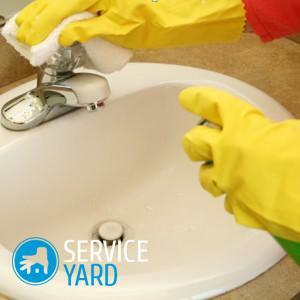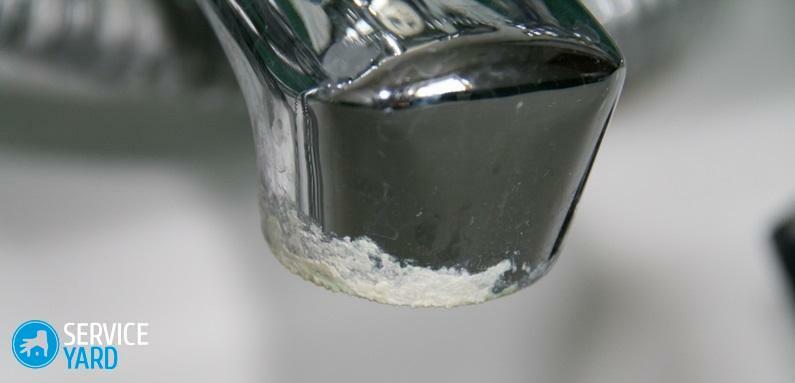
- What is a calcareous deposit?
- What is better not to use to clean the tub?
- What to choose - liquid or powder?
- How to eliminate the plaque from a cast iron and enamel bath?
- Features of care for acrylic bathtubs
- Plastic and glass
- Ceramics and tiles
- Vinegar - universal home remedy
Water from a crane of poor quality inevitably gives its result. In addition to scale, there is also a touch of lime on household appliances, plumbing, and even dishes. In order to understand how to remove limescale by domestic means, you first have to find out what it is. And in this article we will deal with this, as well as with how to get rid of these layers on different materials. We will mainly disassemble household tools suitable for this purpose, as they are cheaper, but we will also make a selection of suitable chemical compounds.
to the contents ↑What is a calcareous deposit?
Rigid water contains a huge amount of calcium and magnesium salts, settling on a variety of surfaces, thus creating a calcareous deposit. In turn, it completely disappears entirely due to the use of acid-containing agents.
It is a mistake to think that a raid of this kind will easily be liquidated. If the surface of the glass shelf can be removed quickly enough, then from the surface of the bath or toilet - not so simple.
Let's consider the most effective methods of cleaning various materials from impending lime scale, which are used in bathrooms.
to the contents ↑What is better not to use for bath cleaning?
There used to be no special baths - they were all made of cast iron with enamel coating. Similar baths and today are in great demand. But despite this, the modern world of plumbing is much more diverse: there are acrylic, steel and even can find baths that are made of durable natural or artificial stone or wood.
You should not only know how to remove limescale, but also with the help of what it is best done, because absolutely each of the baths requires special care.
Important! An improperly chosen product will damage the coating and will cause your bath to look ugly when only a few cleanings are carried out.
Before giving advice on how to remove limescale by household means, let's figure out what tools and procedures should be avoided:
- You can not clean the bath with metal scrapers and brushes because they will scratch any coating, which will lead to the formation of microcracks. In the future, these cracks will be regularly clogged with dirt, and it will be impossible to remove it.
- Do not use acid-based cleaning agents, especially those we use to remove limescale on the toilet surface. They corrode the enamel surface, not to mention acrylic.
Important! Enamelled and cast-iron baths should be cleaned once a week, well, acrylic a bit less often - 1 time in 2 weeks.
to the contents ↑What to choose - liquid or powder?
Here it is easy to understand - any powder in its composition contains abrasive substances:
- Cleaning powders can be used to remove lime deposits from the surface of cast iron as well as enamel baths.
- But for metal and acrylic surfaces, it is best to choose a liquid product in the form of a gel - a similar consistency will allow to distribute the substance evenly over the entire surface and not create an aggressive effect.
Important! Liquid means for the elimination of limescale is not necessary to rub - they simply need to be applied to the surface, left for a certain time and then washed off with ordinary water.
to the contents ↑How to eliminate the plaque from a cast iron and enamel bath?
Remove the lime scale from the enameled and cast iron bath is simple, provided that your favorite font has not been restored, and the coating is still factory. Selecting the substance for cleaning enamel and cast iron baths, as well as for baths and showers made of metallic materials, study:
- Inexpensive means, which in their composition contain anti-corrosive substances. They do not allow damage to the surface, especially if you clean the metal taps. During the cleaning of the bath and sanitary ware in the bathroom with a cheap tool, you will be completely satisfied with the visible result. These substances act exclusively on the plaque and do not damage the surface. Therefore, during the selection of a means to cleanse the limescale in the bathroom, try to look for such a line - anticorrosive inhibitors.
- If you notice nitric or sulfuric acid in the composition, leave this remedy aside because it is heavy artillery for the bathtub and the faucets. Means with these acids are best used for running versions of baths and faucets or for cleaning toilets.
- For the frequent cleaning, it is quite sufficient means based on surfactants, which when released into water, are split, and then affects the problem areas.
Important! If you want to remove limescale by domestic means, then it is best to use ammonia or soda for this purpose. But they must be diluted with water. When using the first remedy, it is also time to ventilate the room.
to content ↑Features of care for acrylic baths
Acrylic baths have appeared relatively recently and are very popular with most people. The surface of the fonts of this species is quite smooth and is easy to clean. Therefore, in order to clean the lime scale from the surface of the acrylic bath, it is sufficient to use a liquid universal agent in which there are no aggressive elements. These include: ammonia, chlorine, acetone.
Important! Excellent reviews have substances "Sanford", "Gel WC 5+", "Sanitary" and others.
 In case you start to regularly check that the bath was clean - rinse after use with slightly hot water and wipe with a cloth of microfiber, then during a thorough cleaning you will just have to wash the bath with an ordinary rag, having previously poured the chosen detergent into it.
In case you start to regularly check that the bath was clean - rinse after use with slightly hot water and wipe with a cloth of microfiber, then during a thorough cleaning you will just have to wash the bath with an ordinary rag, having previously poured the chosen detergent into it.
If you want to remove limescale by domestic means:
- Fill the tub with cool water.
- Pour 0.5 l of 7% vinegar into the water or pour a few sachets of citric acid into the water.
- Leave everything for 1 night or for a day.
- Drain and rinse the tub with clean water, then wipe dry.
Such completely simple recommendations will help you to carefully remove the coating from the acrylic surface.
to the table of contents ↑Plastic and glass
Some products can easily cope with the coating on all kinds of glass surfaces of the bathroom:
- soap solution will easily eliminate non-serious deposits;
- in more severe cases, you can use vinegar or citric acid.
Important! Lime deposits from the surfaces of the glass, for example, from a mirror, shelves, shower partitions, are much easier to clean than plaque from other materials, and regular cleaning at least once in 2 days will completely deprive you of this problem.
To date, on the shelves of supermarkets, as well as ordinary hardware stores you can find all the necessary cleaning materials for the bathroom and any other surfaces. But you should remember that it is better to give preference to cream and pasty, because they are the most sparing and effective during the fight against sediments in the form of calcareous plaque.
to the contents ↑Ceramics and tiles
In case the tiled coatings in the bathroom are not taken care of for a long time, they will soon cease to shine because of the deposits of calcareous plaque. With all this, black stains are likely to appear in the seams. Then you will be forced to think seriously about how to thoroughly clean the surface.
Important! For the systematic care of tiles, use creamy substances that, unlike powdered products, can not damage the surface with abrasive particles. The same effective means can be found that contain chlorine, which also has a disinfectant effect.
to the table of contents ↑Vinegar - universal home remedy
If you set a goal to get rid of a deep plaque, you can contact the long-proven folk remedies. The simplest option is to use 3-9% table vinegar:
- Pour the vinegar into a small container with an atomizer.
- Then spray on the entire tile surface.
- Walk on it with an ordinary brush.
- Wait for several minutes to allow the acid to act on the sediments.
- Thoroughly rinse the surface with running clean water and wipe dry with a household cloth, which is made of microfiber.
Important! If you could not find the vinegar, and at hand only the acetic essence with a concentration of 80%, you must dilute it with plain water before applying it to the tile. Take 12 parts of water for 1 part of acetic essence.
Table vinegar can be replaced with apple:
- Take 1 cup of vinegar, pour it into a convenient container.
- Then heat to 40-45 degrees.
- After this, pour on the walls, leave for 1 night, without washing off, you can add soda to it.
- By the morning, the pollution must necessarily disappear - just rinse the solution.
In this article we have examined how to remove lime scale by home remedies and popular household chemicals. Do it in a timely manner and take preventive measures to care for plumbing, and then the cleaning of the bath and bathroom will have to be done much less often.



